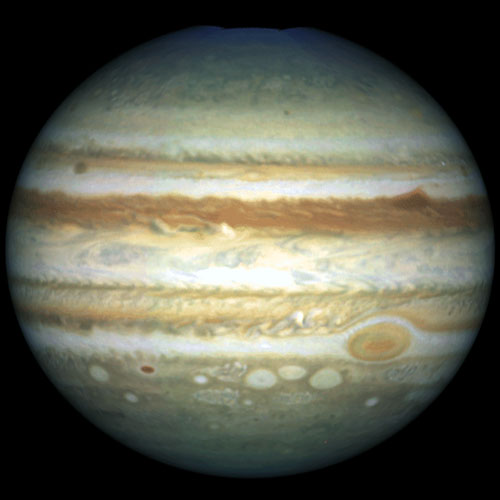مشتری Jupiter
همراه با زحل، اورانوس و نپتون، مشتری یکی از غولهای گازی منظومه شمسی است. جرم آن به تنهایی دو برابر و نیم مجموع دیگر سیارات است. جرم داخلی آن را عمدتاً هیدروژن (71%) و هلیوم (24%) تشکیل میدهد و 5% باقیمانده به عناصر سنگینتر اختصاص دارد. از اینرو ترکیبات آن همچنان شبیه سحابی خورشیدیای است که از آن ساخته شد. جالب است بدانید اگر مشتری جرم بیشتری داشت، قطر آن عملاً کاهش مییافت، بنابراین حجم آن حداکثر حجمی است که یک سیاره با این ترکیبات میتواند داشته باشد.

[1]- هیدروژن فلزی هیدروژنی است بسیار فشرده، بهگونهای که الکترونها میتوانند بهراحتی، شبیه به فلزات، در آن حرکت کنند.
With Saturn, Uranus and Neptune, Jupiter is one of the gas giants of the Solar
System and its mass exceeds that of all the other planets combined by two and a
half times. Its interior mass is primarily made up of hydrogen (∼71%) and helium
(24%) with ∼5% of heavier elements. Its composition thus closely follows that of
the solar nebula from which it was formed. Interestingly, if Jupiter were to acquire
more mass, its diameter would actually decrease, so it is about as large as a planet
of its composition could be.
Jupiter is thought to consist of a dense core surrounded by a layer of liquid
metallic hydrogen lying under an outer layer, about 1000 km thick, composed
very largely of molecular hydrogen. Jupiter is perpetually covered with a cloud
layer about 50 km thick. The clouds are composed of ammonia crystals arranged
into bands of different latitudes made up of light coloured zones between darker
belts. The orange and brown colours in the Jovian clouds are caused by compounds
containing phosphorus and sulphur exposed to ultraviolet light from the Sun. At
differing latitudes, the darker clouds so formed deeper within the atmosphere are
masked out by higher clouds of crystallizing ammonia producing the pale zones
seen between the belts.
"Introduction to astronomy and cosmology" Page 108
 بنام آفریدگار بی همتا
بنام آفریدگار بی همتا